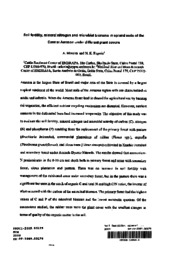Soil fertility, mineral nitrogen and microbial biomass in upland soils of the Central Amazon under different plant covers.
Soil fertility, mineral nitrogen and microbial biomass in upland soils of the Central Amazon under different plant covers.
Autoria: MOREIRA, A.; FAGERIA, N. K.
Resumo: Amazon is the largest State of Brazil and major area of the State is covered by a largest tropical rainforest of the world. Most soils of the Amazon region soils are characterized as acidic and infertile. When the Amazon forest land is cleared for agricultural use by burning the vegetation, the efficient nutrient recycling mechanism are disrupted. However, nutrient contents in the deforested burn land increased temporarily. The objective of this study was to evaluate the soil fertility, mineral nitrogen and microbial activity of carbon (C), nitrogen (N) and phosphorus (P) resulting from the replacement of the primary forest with pasture (Brachiaria brizantha), commercial plantations of rubber (Hevea spp.), cupuaçu (Theobroma grandiflorum), and citrus trees (Citrus sinensis) cultivated in Xanthic Ferralsol and secondary forest under Acrisols Dystric Nitosols. The results showed that ammonium-N predominates in the 0-10 cm soil depth both in primary forest and areas with secondary forest, citrus plantation and pasture. There was no increase in soil fertility with management of the cultivated areas under secondary forest, but in the pasture there was a significant increase in the stock of organic C and total N and high C/N ratios, the inverse of what occurred with the carbon of the microbial biomass. The primary forest had the highest values of C and P of the microbial biomass and the lowest me
Ano de publicação: 2009
Tipo de publicação: Resumo em anais e proceedings
Unidade: Embrapa Pecuária Sudeste
Palavras-chave: Central Amazon, Mineral nitrogen
Observações
1 - Por padrão são exibidas publicações dos últimos 20 anos. Para encontrar publicações mais antigas, configure o filtro ano de publicação, colocando o ano a partir do qual você deseja encontrar publicações. O filtro está na coluna da esquerda na busca acima.
2 - Para ler algumas publicações da Embrapa (apenas as que estão em formato ePub), é necessário ter, no celular ou computador, um desses softwares gratuitos. Sistemas Android: Google Play Livros; IOS: iBooks; Windows e Linux: software Calibre.
Acesse outras publicações
Acesse a Base de Dados da Pesquisa Agropecuária (BDPA) para consultar o acervo completo das bibliotecas da Embrapa.

